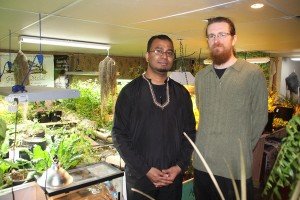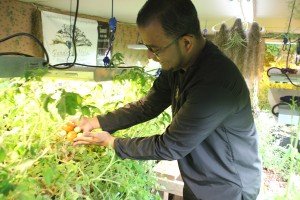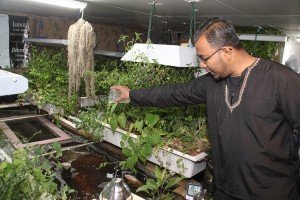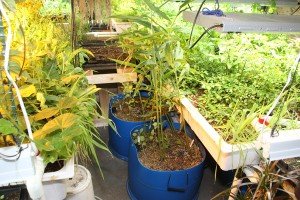Story and photos by TESHA M. CHRISTENSEN
 Gandhi Mahal is pushing the boundaries of what Twin Cities’ restaurants do.
Gandhi Mahal is pushing the boundaries of what Twin Cities’ restaurants do.
After working to grow its own vegetables in community gardens and buying from farmers’ markets, the south Minneapolis restaurant has installed an aquaponics gardening system in the basement.
Gandhi Mahal is the first restaurant in the Twin Cities operating this type of system.
In the dead of winter, patrons were enjoying ripe red tomatoes, crunchy greens, fresh herbs, and tilapia from the basement garden.
The aquaponics garden is part of Gandhi Mahal owner Ruhel Islam’s desire to return to a traditional way of life.
“From the beginning, when we opened this restaurant, we had the vision to be self-sufficient,” said Islam.
He intends to lead by example. “Show the world you can be the change you want to see,” Islam encouraged.
Path to food security
Islam believes that aquaponics gardening is one way Minnesota will become resilient. “This is the future of food security,” he said.
If you grow your own food, you don’t have to worry about the policies in another country, and whether the food supply will suddenly go away, Islam noted.
Gandhi Mahal aims to create peace by pleasing the palate.
Kedrik Lund, who manages the aquaponics system day-to-day, pointed out that when food is trucked, it can lose from 40-50% of its nutritional value in the first week. “If you go straight from the plant to your table, you get so much more vital food ingredients onto your plate,” Lund said.
 Year-round gardening in Minnesota
Year-round gardening in Minnesota
Aquaponics gardening addresses many of the challenges gardeners face in Minnesota’s climate. Instead of gardening only four months of the year -- or six if you factor in fruit trees, you can push it to year-round.
Lund is also enthusiastic about how aquaponics uses discarded or marginalized spaces, such as basements and rooftops.
“This idea would be great for a family of four,” Lund said.
Both Lund and Islam dream of the day when a system like this isn’t an oddity.
 How to create an aquaponics garden
How to create an aquaponics garden
Islam has been dreaming of an aquaponics system in the basement since 2010, but waited to proceed until he had purchased the building he occupies. Long-term he’d like to expand into a larger space and move the sun down through a tunnel.
He enlisted Spark-Y Youth Action Labs to design his basement garden in early 2014. They obtained a license from the Department of Natural Resources for the fish pond in June 2014. And then they began construction.
The Gandhi Mahal aquaponics system relies heavily on 3 amp florescent light fixtures with T5 bulbs. These are high-output, full-spectrum bulbs. When Lund wants to encourage the plants to move from growing to producing, he switches the color from the green spectrum to the red spectrum to mimic that of later summer.
They also switch up the amount of time the lights are on to mimic the seasons.
They are experimenting with other types of lights, including induction and high pressure sodium (HPS) light.
Islam and Lund would like to move towards LEDs, but the cost is prohibitive right now. The advantage of the LEDs is that although it costs more to purchase initially, the bulbs last much longer than florescent ones.
“The great thing about aquaponics is that you can do it as low tech as you want to,” said Lund. “We’re only limited to our imagination.”
Many of the items used in their system were purchased off Craigslist.
Instead of using dirt, they opted for Hydro Clay pellets made of pressure-treated and heat-treated bentonite clay. In addition to being lightweight, it offers flexibility in moving plants. It holds roots in place well, and allows the plant to establish and move roots throughout the system, according to Lund. It also increases the overall surface area of the garden, and doesn’t clog their pipes like soil would.
“We are constantly learning,” said Lund.
One cup of regular garden soil contains 100,000 beneficial bacteria and 50,000 nematodes. The challenge of the aquaponics system is to replicate that biological intelligence. It takes trial and error.
 They are able to do that in part by combining the fish pond with the garden. The fish and the plants help each other, noted Islam.
They are able to do that in part by combining the fish pond with the garden. The fish and the plants help each other, noted Islam.
The water in the system is recirculated and reused, water from the fish fertilizing the plants and the plants cleaning the water for the fish.
It is a zero waste system.
Bins under the tables house red wiggler worms, and that soil is used to get plants started.
Air pumps and fans keep the air moving.
According to Islam, the restaurant energy bills have increased 10% since implementing the aquaponics garden, a small price to pay for fresh vegetables and self-sufficiency.
Over the winter, they harvested spinach 30 times.
“The benefits have been greater than we were even expecting,” said Lund.
What’s next?
“This is a small part of a bigger vision,” Islam observed.
What’s next? Year-round rooftop gardening to take advantage of the sunlight. Chickens. Transforming Lake St. into a food production site through self-watering planters. (Watch for upcoming seminars on how to make your own.)
Islam is currently working on a partnership with the Anne Sullivan School for a community garden that the students will assist with. His own two daughters attend that school.
“We want to create more farmers,” said Islam. “To do that, you have to start with the children.”
Comments
No comments on this item Please log in to comment by clicking here